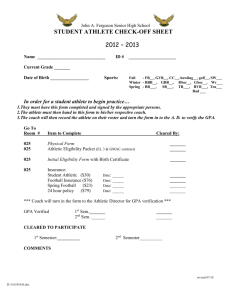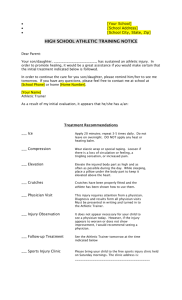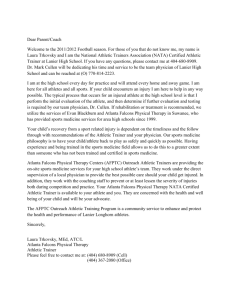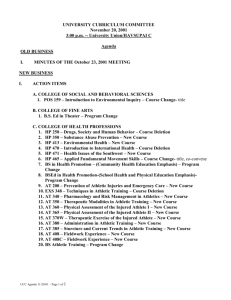Athletic Training Policy - Hanover County Public Schools
advertisement
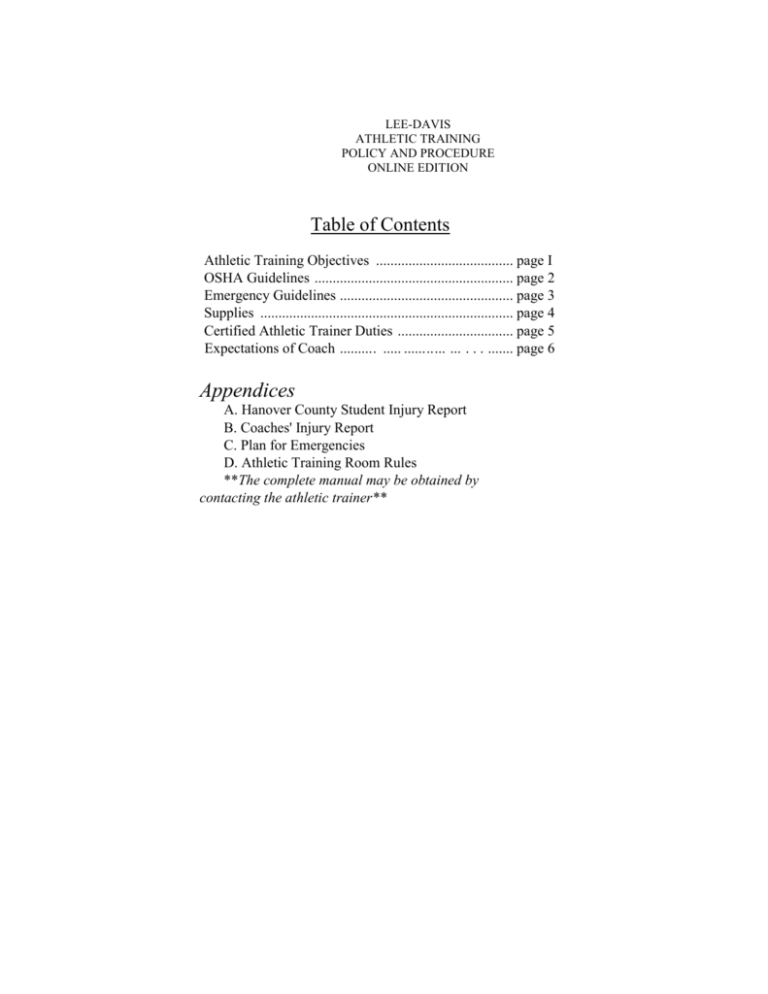
LEE-DAVIS ATHLETIC TRAINING POLICY AND PROCEDURE ONLINE EDITION Table of Contents Athletic Training Objectives ...................................... page I OSHA Guidelines ....................................................... page 2 Emergency Guidelines ................................................ page 3 Supplies ...................................................................... page 4 Certified Athletic Trainer Duties ................................ page 5 Expectations of Coach ......... . ..... ...... .. ... ... . . . ....... page 6 Appendices A. Hanover County Student Injury Report B. Coaches' Injury Report C. Plan for Emergencies D. Athletic Training Room Rules **The complete manual may be obtained by contacting the athletic trainer** Athletic Training Objectives The duties and responsibilities of the certified athletic trainer are to provide optimal care for all student athletes including the prevention, recognition, evaluation, management and rehabilitation of injuries to student athletes participating in a VHSL sponsored sport. The certified athletic works within a network of physicians, physical therapists and other allied health care professionals to provide the best, most in depth care for the student athlete. The certified athletic trainer also serves as a link in a chain consisting of the physician, athlete, parent, coach and athletic director. By sustaining a strong chain the student athlete is assured a full recovery and a safe return to athletic participation. The following policies and procedures will outline the specific duties of the position of certified athletic trainer. This document will also outline the expectations that the certified athletic trainer has of the coaching staff, administration, the student athletes and parents. Injury and Treatment Procedures Documentation: The certified athletic trainer must be notified as soon as possible in the even of an injury to the student athlete. If the certified athletic trainer is not available to assess the injured student athlete, the coach or assistant should provide first aid within their ability. The coach or assistant should also document the injury completing the Hanover County Injury Form (Appendix A). This should be filled out in its entirety and a copy should be provided to the front office and to the certified athletic trainer. Copies of the Coaches Injury Report (Appendix B) should be filled out and turned into the certified athletic trainer so he/she can document the injury. Documentation is very important for legal liability reasons. Communication: Communication is an integral factor in working with large numbers of people who are necessary to endure the health and safety of student athletes. Communication via written and verbal correspondence is very important to the documentation process. Student Athlete Participation Following Injury: The playing status of a student athlete is at the discretion of the certified athletic trainer and the physician if he or she is present. A student athlete will not be permitted to participate where injury or insult to injury may occur. If a student athlete has seen a physician and is deemed unable to participate for a period of time, the certified athletic trainer or coach cannot under any circumstances allow the student athlete to play until a physician has released him or her. A student athlete under a physician's care must present a note from the physician stating when he or she may return to participation. The certified athletic trainer reserves the right to remove the athlete from participation if the athlete cannot perform necessary sport-specific activities, even though a physician has cleared him or her. In the event this situation does arise the certified athletic trainer will consult the physician for further instructions. 1 Supplies Issued to Coaches Each head coach will be issued a stocked first aid kit, ice cooler and water cooler. These items must accompany the team at all practices and games. Each first aid kit is stocked with gloves, gauze, ice bags, band-aids, etc. The certified athletic trainer should be notified if additional supplies are needed. These items should be returned to the certified athletic trainer at the end of the season. If a cooler or first aid kit is lost or stolen, it is the responsibility of the coach to replace the item out of their athletic budget. These items are expensive and replacing them decreases the amount of first aid supplies that may be purchased. It is understandable that coolers and kits get damaged, but please do your best to take care of these items. 4 OSHA Guidelines: The Occupational Safety and Health Administration require that blood and other bodily fluids be handled in a specific manner. Due to the nature of some sports, it is very likely that a coach or certified athletic trainer will have to work with a student athlete that is bleeding from a wound or who has a bloody nose. With blood borne diseases and infections such as HIV, HBV and Hepatitis B, it is very important to follow the guidelines as set forth by OHSA and Hanover County for your safety as well as others. Every employee is responsible for viewing the OSHA videotape at the beginning of the school year. The guidelines include the following: Use gloves when working with a student athlete that is bleeding. Cover the student athlete's wound securely so it does not come off during competition. Remove blood from uniforms before returning to play. (It is a good idea to carry an extra uniform for this purpose.) Put all soiled materials in a red biohazard bag and give it to the certified athletic trainer or nurse for proper disposal. Wash soiled towels or uniforms separate form other towels or uniforms. Use bleach if possible. Use a 10:1 water to bleach solution for soiled surfaces. - Wash hands thoroughly with soap and water or use an antimicrobial toilette or gel if water and soap is unavailable. 2 Emergency Procedures: • • • • • • • Assess the situation to make sure it is safe to approach Remember: Check, Call, Care Check ABCs: airway, breathing, circulation If any of the above items are compromised, call EMS=911. If you do not have a cell phone, try to send another person to call EMS while you stay with the injured person. Do not attempt to move the student athlete. If the student athlete is unconscious, expect a head or neck injury. Stabilize the student athlete. If he or she becomes conscious, keep him or her still. Have another coach notify the athlete's parents. If in doubt of severity of the injury call 911 (remember If in doubt, ship them out) Being Prepared: Create your own emergency plan utilizing the above procedures and the following tips: • Eliminate foreseeable risks • Become certified in First Aid and CPR • Know where the nearest phone is located • Obtain emergency cards on all student athletes, know existing or past medical problems, be able to tell the operator about the injury, the care provided, location and give the number you are calling from. • Do not hang up the hone until the operator tells you to do so. • Send someone to meet the ambulance, so they know exactly where they are going. • Keep teammates away from the scene. Prepare them my telling them what they should do in case an emergency arises. For example, the football team moves over near the sideline, soccer teams may stand by their goal. Please remember to document all injuries. What may appear as a minor injury at one moment may be masking a more severe injury that may appear hours later (ex concussion). Keep parents informed about injuries to their children, as a student athlete may neglect to tell a parent that in injury has occurred. If you need any assistance developing your emergency plan, please feel free to contact me. I have also included an article (Appendix C) to assist you in the construction of an emergency plan. "Remember that being prepared will allow you to stay calm and provide the best possible care you can for the injured athlete, thus reducing your chance of negligence ** 3 Certified Athletic Trainer's Duties and Responsibilities Provide optimal health care to all student athletes by maintaining a Safe and healthy environment. Be a positive role model to student athletes. To file all physicians' notes and injury reports. To follow physician's prescribed orders as per note accompanying athlete. To maintain daily treatment logs. To record and maintain evaluation and rehabilitation records on student athletes. To check physicals for health risks, physical date and completeness. To perform seasonal inventories and pre prepare a yearly budget Provide medical coverage for: All J.V. and Varsity football games and practices. Home games and meets for wrestling, J.V and Varsity boys and girls' basketball, and J.V. and Varsity boys and girls soccer. Provide athletic training room hours: Hours will vary depending on events to be covered and season Throughout the preseason, the certified athletic trainer will be available an hour to forty-five minutes prior to practice time. Once the school year starts, the hours for that particular day will be posted on the door. On days there are no games scheduled, the athletic training room will remain open until 5:30. Please inform the certified athletic trainer as soon as possible of any schedule changes. Tournaments to be hosted by Lee-Davis High School will be covered and considered an extra duty. Compensation will be discussed with the athletic director. 5 Expectations of the Coach By the Certified Athletic Trainer To work with the certified athletic trainer in providing a safe and healthy environment for all student athletes To report all injuries to the athletic trainer so that the proper paper work can be filled out and filed To fill out a county injury report if the certified athletic trainer is not available and to forward a copy to the front office and to the certified athletic trainer. In addition, fill out a coaches' report. To follow all emergency procedures as outlined Bring the first aid kit, ice cooler and water cooler to all practices and games. To obtain and maintain emergency cards on all athletes and have the cards present at all games and practices. A good storage place is the medical kit. To report game schedule changes at least 24 hours in advance to ensure coverage. All coaches are encouraged to obtain first aid and CPR certifications. Hanover County does provide one and two-day certification courses at no charge. Parent and Student Athlete Responsibilities Have a completed VHSL physical form on file before the first day of practice Follow the rules of the athletic training room (Appendix D). Report all injuries to the certified athletic trainer regardless of severity. If the injury requires additional medical assistance, a physician's note stating the diagnosis and return to play criteria/date must accompany the student athlete. The student athlete will not be allowed to participate without this note. Lee Davis Coaches' Injury Report (non-emergency) 1. Name of Athlete 2. Date injury occurred 3. Sport 4. What happened? 5. Treatment Administered if any 6. Date when athlete will come see ATC 7. Additional Comments 8. Form Completed by Thank you. Bethann Jones, ATC Lee Davis Coaches' Injury Report (non-emergency). 1. Name of Athlete 2. Date injury occurred 3. Spots 4. What happened? 5. Treatment Administered if any 6. Date when athlete will come see ATC 7. Additional Comments 8. Form Completed by Thank you. Bethann Jones, ATC Appendix D Athletic Training Room Rules: 1. 2. 3. 4. 5. 6. No Cleats No Horseplay No Cussing Student athletes must sign in prior to treatment Report all injuries to the certified athletic trainer Get to the athletic training room on time. Do not use the athletic training room as an excuse to be late to practice 7. The certified athletic trainer must issue all supplies. 8. Hot packs and whirlpool use will only be used in the presence of the certified athletic trainer. 9. The athletic training room is only to be used for treatment or rehabilitation. No hanging out!
